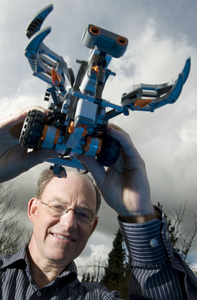Computer games move out into the real world
For two decades, children of all ages have been stuck to their computer screens, entertaining themselves by playing computer games…
 ...from the simple Pac-Man played on a Commodore 64 in the late 80’s to World of Warcraft and other advanced games today. With game consoles such as the Nintendo Wii, games have now become more active. Many new games take place in the living room rather than in front of the computer, allowing players to play rock guitar, golf, tennis and much more. But now a newly-founded company, GamesOnTrack A/S, has initiated a development project to release the computer game from the computer to an even higher degree. ...from the simple Pac-Man played on a Commodore 64 in the late 80’s to World of Warcraft and other advanced games today. With game consoles such as the Nintendo Wii, games have now become more active. Many new games take place in the living room rather than in front of the computer, allowing players to play rock guitar, golf, tennis and much more. But now a newly-founded company, GamesOnTrack A/S, has initiated a development project to release the computer game from the computer to an even higher degree.
“Our mission is to go one step further, make the interactive game even more physical and for instance make it possible for the players to program the devices they’re playing on. At the same time, the gaming device needs to be wireless, allowing players even more freedom of movement,” Managing Director and founder of GamesOnTrack, Niels Bo Theilgaard explains.
High-speed positioning
If the games are to take place in the real world in which the player is located, rather than in the virtual on-screen reality, the game needs to be able to ’read’ its physical surroundings. And not only does the game need to determine its location in physical space – it also needs to do so super-fast. Even when the player is moving.
“First of all, we need to be able to perform indoor positioning with a higher level of accuracy. Therefore, I spoke to the Managing Director of CISS, Kim Guldstrand Larsen, about finding a solution faster and more precise than a GPS. As a result, we – and three students – have been working on a model with a motor-driven moving object which measures its location by using a number of markers placed around the room. The system is called Radio Frequency ID, and it is used for e.g. registering goods in storage areas. The small ‘tags’, markers, can store lots of data – more than would be possible in for instance bar codes,” Niels Bo Theilgaard explains.
They succeeded - almost
The goal was to reach an accuracy of one cm per second – but they didn’t quite succeed in that. During the project, they reached an accuracy of 10 cm per two seconds. It proved quite a challenge for the project that the RFID system had to manage one moving object at a time.
“It was a very exciting project, and we have gained a lot of valuable information. We have now initiated a new, revised, confidential project, because we believe we can make further improvements. We are already busy building a new prototype, in which, moreover, we will incorporate wireless technology,” Niels Bo Theilgaard explains and continues: “I am convinced that we will succeed. And then we will be holding a very unique new game technology which, by the way, will have a wide range of other uses too!” |
|
|

